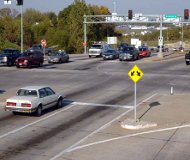9/26/2011
Missouri: Violations Still Down with Longer YellowsRed light ticketing drops 86 percent in Arnold, Missouri after state lengthens yellow light timing.

Photo enforcement advocates downplay the benefit of increased yellow time in addressing the problem of red light running. New evidence from Arnold, Missouri shows that red light cameras continue to flash at a much lower rate since the state mandated longer signal timing at a number of photo-enforced intersections.
Arnold was the first jurisdiction in the Show Me State to allow a private company, American Traffic Solutions (ATS), to mail traffic tickets to residents. Since 2005, ATS has handed out more than 30,000 tickets worth over $3.1 million. In 2010, tickets were being pumped out at an average rate of 800 per month. With longer yellows, that figure averaged just 113 through July and August using the most up-to-date data available.
Timing changes were made at and near the red light camera intersections. Yellows increased from 4.0 to 5.0 seconds at three intersections along Missouri Route 141 on February 24. Smaller changes were made on April 15, including a boost from 4.0 to 4.4 seconds at northbound 141 and US 61/67, a 4.0 to 4.5 second change at northbound US 61/67 at Rockport School, and from 4.0 to 4.7 seconds at southbound Vogel Road at Richardson Road (4.3 seconds at the northbound approach).
While a difference of 0.4 to 1.0 seconds in the length of the yellow light might seem insignificant, the extra margin of safety is critical. The vast majority of straight-through red light "violations" happen when a driver misjudges the end of the yellow light by less than 0.25 seconds -- literally the blink of an eye (view Texas Transportation Institute (TTI) chart). With those longer yellow times, the city and ATS are losing $780,000 in annual revenue -- an 86 percent drop.
The Insurance Institute for Highway Safety's former top researcher, Richard Retting, argued strongly against the use of yellow signal timing beyond the bare ITE minimum values. His research is cited by the Federal Highway Administration (FHWA) in its "Toolbox of Engineering Countermeasures," which is used by cities to set up intersections prior to the use of automated ticketing machines.
"Present thought is that longer intervals will cause drivers to enter the intersection later and it will breed disrespect for the traffic signal," the FHWA document explains. "The tendency for motorists to adjust to the longer interval and enter the intersection later is referred to as habituation. The before-and-after study by Retting and Greene evaluated the presence of habituation to the longer yellow... The authors concluded that habituation to the longer yellow did exist...."
Retting is now employed by a red light camera company.


